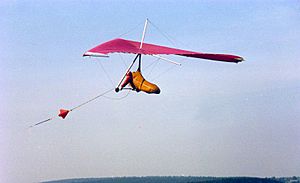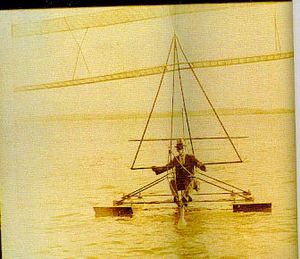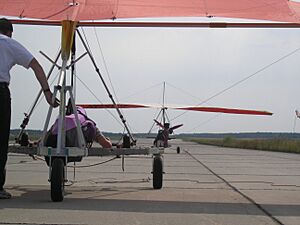Kite control systems facts for kids
Kites come in many shapes and sizes, and they are used for lots of different things. Because of this, there are many ways to control a kite. People who make kites, kite flyers, scientists, and engineers are always finding new and exciting ways to control them.
Contents
Controlling Kites with One Line
Flying Kites Super High
In 2000, a special kite flew very high to set a record. To control it, the kite had a system that changed how the wind hit its wing. This kept the pull on the line under 100 pounds. The team also used bungee cords and pulleys at the bottom of the line. This helped to smooth out strong wind gusts.
For safety, the kite had a radio beacon so other aircraft could see it. It also had bright strobe lights for visibility. When the line was under high tension, special reels and pulleys were very important for control. The team even had to fix parts during the flight!
Extra Ways to Control Single-Line Kites
Sometimes, extra tools are used to control kites with just one line. Some devices on the kite can react to how much the line pulls or how the wind hits the kite. Special reels let you control the length and tightness of the kite line.
You can also control a single-line kite by moving the bottom end of the line. If you move it left, right, or into the wind, the kite will react. There are also parts on the kite's bridle (the lines that connect to the main kite line) that can be adjusted. This changes how the kite sits in the air, making it fly in a certain way.
One inventor, Kenneth C. Howard, even created a device that lets you change these settings while the kite is flying. He explained that by quickly loosening and tightening the string, you can make the kite climb, dive, or fly left or right.
Controlling Fighter Kites
Most kite fighting uses single-line kites. The person flying the kite learns to make quick movements like tugs, jerks, and releases. These actions make the kite move in different directions, even though it's usually unstable.
The goal is to attack other kites or defend your own. Kites built for fighting are designed carefully. This helps them stay steady for a short time when the pilot makes a move.
Kites from History
Early Kite Control Methods
Over time, many different ways to control kites have been invented. Here are a few examples:
- Wright Brothers: These famous inventors used a system with four lines and two handles to control their kites.
- George A. Spratt's Triangle Frame: Dr. Spratt designed a special triangle-shaped control frame. This frame helped pilots shift their weight to steer early gliders and ultralights.
- Paresev: This experimental aircraft used cables and a control stick. The pilot hung from the kite and shifted their weight to steer it.
- Blue-Hill Observatory: They used a control system made with piano wire for their kites.
- Barry Hill Palmer: In the early 1960s, he experimented with many ways to control hang gliders. He eventually found the same triangle control frame that George Spratt had used. This frame allowed pilots to shift their weight to control the glider.
Power Kites with Medium Lines
Power kites are strong kites used for sports like kitesurfing. They are controlled by 2 to 5 lines. Simple systems let you steer by pulling on either side of the kite. More lines add different ways to control the kite:
- Changing the Angle: Pulling lines attached to the front of the kite makes the wind hit it less. This reduces how much the kite pulls.
- Braking: A line that pulls down the back edge of the kite acts like a brake. You can use it to make the kite turn fast if pulled on one side. If pulled evenly, it helps bring the kite down.
- Changing the Kite's Shape: This is useful if the kite is on the water. A fifth line can sometimes be used to change the kite's shape. This makes it much easier to relaunch the kite from the water.
The lines connect to different types of controllers:
- Rings or Wrist Loops: These are often found on smaller kites.
- Two-Line Bars: These are common for kitesurfing kites and other recreational kites. They usually have a leash that attaches to your wrist. If you let go of the bar, the kite will fall safely.
- Four-Line Bars: These are found on many kitesurfing kites. They let you change the angle at which the wind hits the kite. There's often a "chicken loop" that connects to your harness. If you let go of the bar but stay connected to the chicken loop, the kite loses most of its power. There's also usually a safety system to completely de-power the kite if needed.
- Five-Line Bars: These are like four-line systems but with an extra fifth line. This line can help with de-powering the kite or relaunching it from the water.
- Handles: These are often used with four-line foil kites. Each handle has two lines attached. One handle controls the left side, and the other controls the right. They also have "brake lines" that go to the back edge of the kite, allowing you to brake or turn.
Controlling Kites for Electricity
When kites are used to generate electricity high in the sky, humans usually can't control them directly. The lines pull too hard! Instead, special machines called servo mechanisms do the controlling.
Some ideas for controlling these large kites include:
- Pulling the lines with powerful winches.
- Turning the points where the lines attach around a central pivot.
- Moving the line attachment points back and forth using special motors.
Controlling Kite Rigs
Kite rigs are systems that use kites to move vehicles. These can be boats, buggies, or vehicles that slide on snow or ice. They can be simple, like a person flying a kite while on a skateboard. Or they can be complex systems with automated controls fixed to a vehicle. Unlike traditional sails, kites are flown from lines, not supported by tall masts.
Kites for Big Ships
Kites used to pull large ships can be huge, sometimes hundreds of square meters in size. They need special places to attach, a system to launch and bring them back, and computer-controlled steering.
The SkySails system for ships uses a large kite, an electronic control system, and an automatic system to pull the kite back in. This kite is much larger than kitesurfing kites. It's an inflatable kite, not one that fills with air as it flies. A control pod is used instead of many direct lines. Only one main line goes from the kite to the ship. This line also carries power and commands to the control pod.
The kite is launched and recovered by a moving mast or arm. This arm holds the kite by its front edge and also inflates and deflates it. When not in use, the mast and deflated kite fold away neatly.
Target Kites
"Target kites" usually refer to kites used during wartime. They were flown from ships for anti-aircraft gunnery practice. Paul Garber, who worked at the Smithsonian, invented them.
These kites were about five feet tall and looked like regular two-stick Eddy kites. They were sky blue with the outline of enemy aircraft painted in black. A small rudder was attached to the bottom of the kite. This rudder was controlled by two lines, which also flew the kite. These lines came down to the ground and connected to a "flying bar" or a special reel.
Indoor Kites
For indoor kites, a simple wand or pole with a string on the end is often used. This lets you gently lead the kite around inside a building.
Hang Gliders
Unpowered Short-Tethered Hang Gliders
Hang gliders are large kites with a stiff frame. Unlike long-lined power kites, hang gliders use a short line called a "hang line." This line connects the pilot's harness to the kite. The hang line often splits into two, three, or four main lines that attach to the harness.
Pilots control the hang glider by grabbing the "control frame" (a stiff part of the kite's frame). They push or pull this frame left, right, forward, or backward. This changes the glider's center of gravity, which helps steer the kite. This is often called "weight-shifting."
The spot where the hang line connects to the kite is very important. It needs to be carefully chosen for stable flight. Even if a pilot lets go of the control frame, a well-designed hang glider will fly steadily. However, because of wind gusts, pilots almost always keep their hands on the control frame.
Powered Short-Tethered Hang Gliders
In this system, the pilot wears a harness with an engine or motor attached. The kite itself doesn't have an engine. The control system is similar to unpowered hang gliders. The pilot still shifts their weight to control the kite. When the engine is on, the pilot positions themselves so the kite line pulls the wing correctly, just like in regular kiting.
Towing Hang Gliders by Airplane
Towing a hang glider by an airplane involves complex control. The hang glider pilot is the main decision-maker, but the ultralight tug pilot also has important control duties. Special training is needed for both pilots.
Towing Hang Gliders with a Static Line
In this method, the tow line stays the same length during the entire tow. The ground vehicle driver has special control duties. The hang glider pilot controls the kite differently from other tow methods. Learning these differences is part of professional instruction. Dealing with unexpected events is a big part of the training.
Towing Hang Gliders with a Winch

This method involves a winch operator who controls the length of the tow line. The line starts long and gets shorter as the winch reels it in. This changes how the hang glider pilot needs to control the kite. This is different from static-line towing, where the line stays the same length.
Bungee Launching Hang Gliders
Bungee launching uses a very stretchy tow line. When pulled tight, the line is long. As it launches the kite, the line shortens. The pilot controls the kite's wing by moving the control frame or other parts. Professional instruction is highly recommended for this method.
An inelastic part of the bungee assembly helps protect the pilot if the bungee breaks. A small parachute on the tow line can also slow down the bungee's fall after it's released. Bungee launches are often used on slopes or for short flights on flat ground.
Paragliders
Paragliders are flexible wings that are not stiff. They don't have engines mounted on them. Instead, lines from the wing go down to a person or a payload. This person or payload might be falling by gravity, which pulls the wing through the air. If the person or payload also has an engine, it's called a powered paragliding system.
All paragliding systems use an unpowered kite, whether the person or payload is powered or not. The control systems vary depending on what the paraglider is used for. This can range from dropping military supplies to sport flying or even small model paragliders.
Governable Gliding Parachutes
These are free-flying kites that can be steered. They are used to deliver sensitive items, for sport skydiving, or for BASE jumping. When carrying people or delicate payloads, a "slider" is used to slow down the opening of the parachute. This reduces the shock of opening.
The wing itself has no engine and is controlled by lines that attach to platforms or harnesses. The size and design of the wing are chosen for its specific use, considering how it packs, opens, and how fast it sinks. Control systems are specialized for each use. Sometimes, they include radio control from a distance.
Kite Aerial Photography
Kites used for taking pictures from the air (KAP) are usually controlled with the same reels and spools as other kites. The best KAP photos are often taken at lower heights (around 100-200 feet), so no special equipment is needed. It can be tricky to fly the kite near tall trees or buildings, so being able to pull the kite in quickly is helpful.
The camera is attached to the kite line some distance below the kite. It's best to use a pulley system, like the Picavet system. This allows the camera to stay level even if the kite moves around.
More advanced kite photography setups can include live video and radio controls. This lets you see where the camera is pointing and change its direction from the ground. This is much better than a simple setup that just clicks pictures every few minutes. However, these advanced systems are heavier, so they need stronger winds to fly, which can limit when you can take photos.
Solar Sail Kites
Scientists are even working on "solar kites" that fly in space! These kites would have very few moving parts to control their movement around Earth, the Moon, or other planets. The idea is that the kite's mass resists the push of light particles from the sun. Controlling the kite to move away from gravity's pull helps it stay on its path. This makes it a type of kite in the flow of light.
These solar kites would receive starting data and then track stars to know their position. They would use three main ways to control their direction:
- Changing the position of the payload to shift the kite's center of mass. This can be done with special actuators.
- Heating some of the struts (support beams) that hold the payload. This makes them longer than cooler struts, changing the kite's center of mass.
- Using tiny "photo thrusters" (heated wires) to make small adjustments to the kite's direction. These don't push the kite forward but only change its angle.
These methods aim to give precise control using very little power. Scientists are looking at many different ways to control these solar kites or solar sails.
Images for kids







